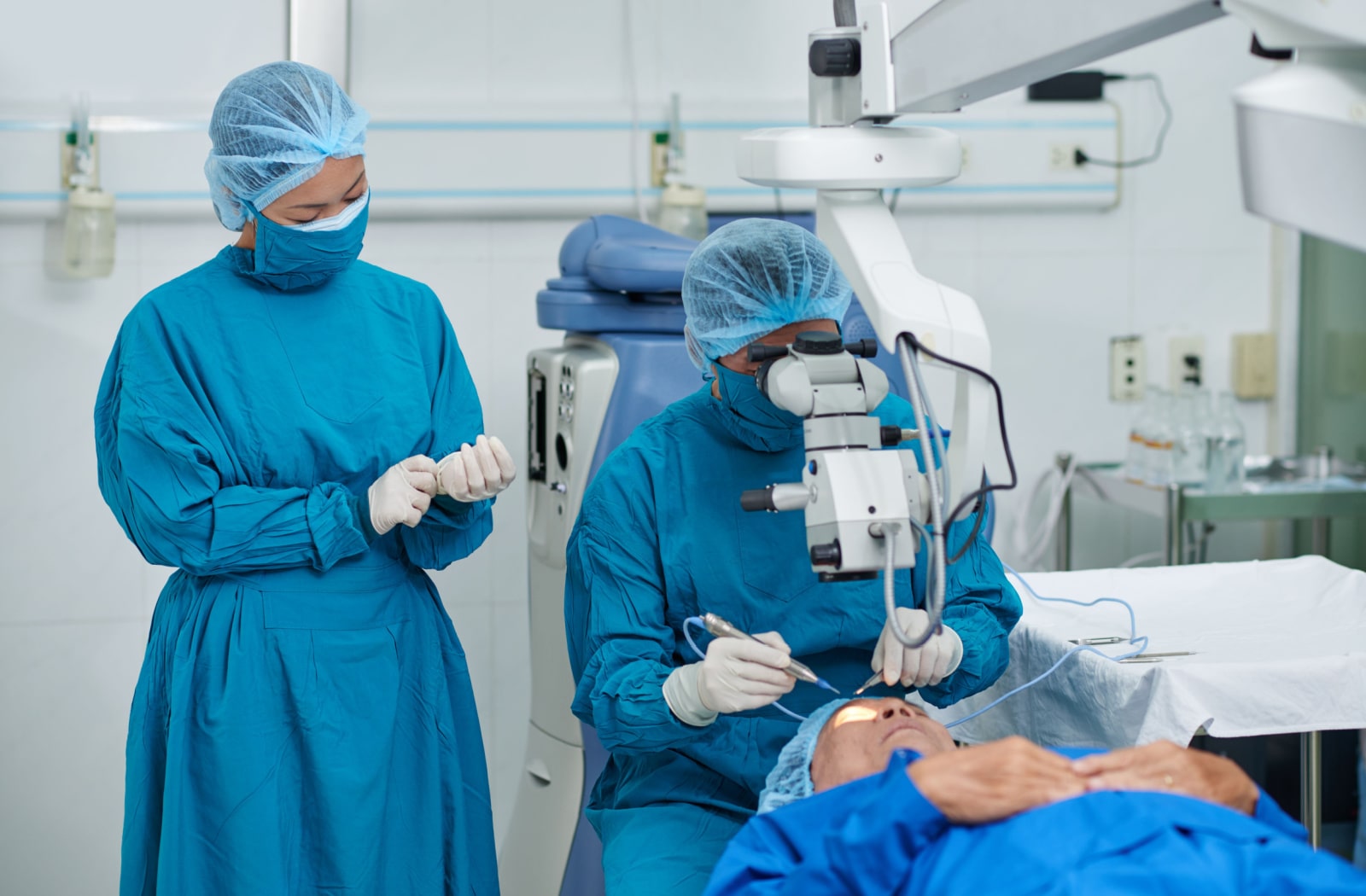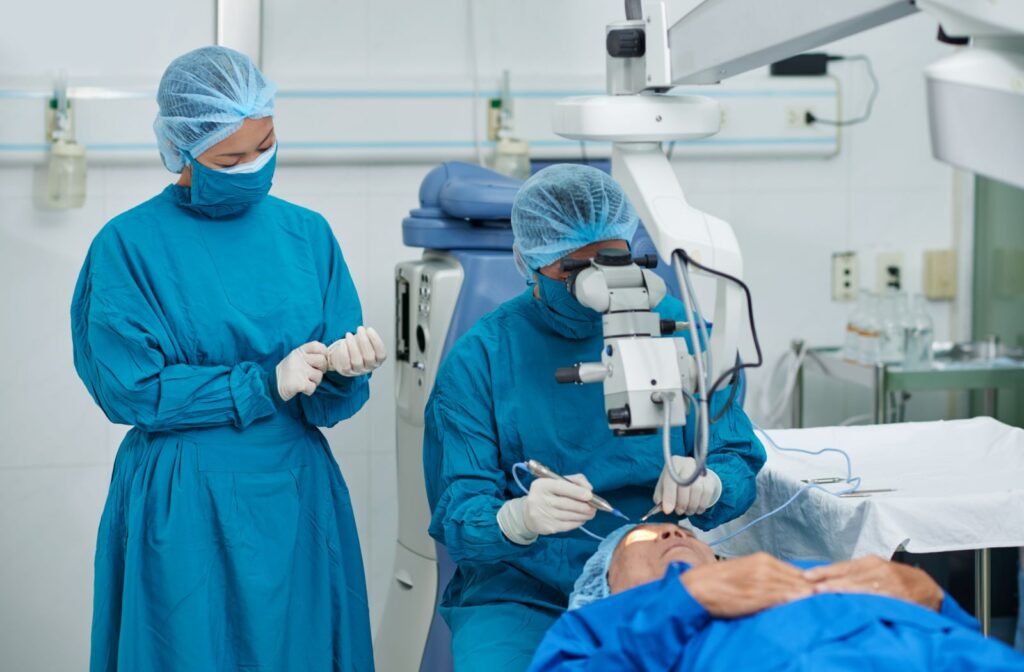As you age, it’s normal to experience some vision problems, and cataracts are among the most common we see in eye exams. Cataracts can cause the lenses of your eyes to become cloudy and can lead to vision loss if left untreated.
Cataract surgery is a common and effective procedure that involves removing the cloudy lens of the eye and replacing it with an artificial lens. The procedure for cataract surgery typically takes between 10 and 20 minutes per eye, but the exact duration can depend on several factors, including the severity of the cataract and your overall health.
What Are Cataracts?
Cataracts are a natural, age-related condition that starts with a gradual loss of vision clarity.
Your eyes’ lenses are made up of proteins, collagen, and fluid that are organized in a way that allows light to pass through them and produce clear images. As you age, the proteins in your lens can start to break down and clump together, forming a cataract that causes the lens to turn cloudy and opaque.
Cataracts can lead to several vision problems, such as:
- Blurred vision
- Poor low-light vision
- Dull colour vision
- Double vision
- Halos around lights
- Light sensitivity
What Are the Risk Factors for Cataracts?
Age is a common reason why many people develop cataracts. However, certain circumstances can heighten your risk, including:
- Diabetes
- UV exposure and photokeratitis
- Smoking
- Hypertension (high blood pressure)
- A previous eye injury
- Complications from other surgical procedures
- Excessive alcohol use
What Is Cataract Surgery & When Is it Necessary?
Cataract surgery involves removing your eye’s natural cloudy lens and replacing it with a clear, artificial intraocular lens (IOL).
If left untreated, cataracts can cause increasing vision loss, affecting your ability to do day-to-day activities safely. The most common reason to undergo cataract surgery is to improve your vision and restore your quality of life.
Depending on a person’s age and lifestyle, and the severity of their cataracts, some people may choose to delay surgery. Early onset of cataracts may make surgery a more pressing concern, especially if it impedes your ability to work, drive, cook, or perform other essential daily activities.
The Cataract Surgery Process
Preoperative Procedures
Before cataract surgery, you’ll typically have a comprehensive eye exam to assess your visual acuity, eye health, and cataract severity. Your surgeon and family eye doctor can then determine the right type of IOL implant for your condition.
Immediately before the surgery, you’ll typically be given eye drops to numb your eye.
The Surgical Procedure
Cataract surgery is one of the most common surgical procedures in Canada and typically takes between 10 and 20 minutes per eye. The procedure is almost always outpatient, and in most cases, you are able to return home the same day.
During the procedure, your surgeon will typically first make small incisions in the cornea to access the eye’s natural lens. They often then use ultrasound waves to break up and remove the cataract. Finally, the surgeon will replace the natural lens with an IOL implant.
There may be different lens options available to correct your vision problems. Some of the most common include:
- Monofocal lenses that can provide clear vision at one particular distance
- Toric lenses that can correct astigmatism
- Multifocal lenses that can provide clear vision at multiple distances
Postoperative Care
After surgery, you should avoid driving, lifting heavy objects, or performing physically taxing tasks. You should avoid driving immediately after your procedure and plan to arrange transportation for getting home.
Your eye care team may recommend wearing an eye shield or glasses to protect your eye from accidental bumps and rubbing. Antibiotic or corticosteroid eye drops can be prescribed to prevent infection and reduce inflammation.
Within a few days, you’ll often be able to resume most of your everyday activities, and many people are completely healed within several weeks.
Follow-Up Exam
A follow-up eye exam is crucial to assess the outcome of your surgery and monitor any changes in your vision. Your optometrist can also confirm your IOL is in the correct position and that your eye is healing properly.
After cataract surgery, you should visit your optometrist immediately if you notice complications, such as:
- Loss of vision
- Strong pain
- Extreme eye redness
- Flashes and floaters
You should continue to make regular appointments with your optometrist to manage any other eye conditions or changes in your vision.
How Can You Prevent Cataracts?
Maintaining a healthy lifestyle can help reduce your risk of developing eye conditions like cataracts. Some lifestyle changes that may help prevent cataracts include the following:
- Manage other health conditions, such as diabetes
- Protect your eyes from UV rays
- Avoid smoking
- Eat a balanced, healthy diet
- Schedule regular eye exams
Prioritize Preventative Eye Care
Detecting cataracts and other eye conditions early is essential for developing a personalized treatment plan. Schedule an appointment at View Pointe Vision + Style to monitor your vision, preserve your eye health, and get support for your well-being.


